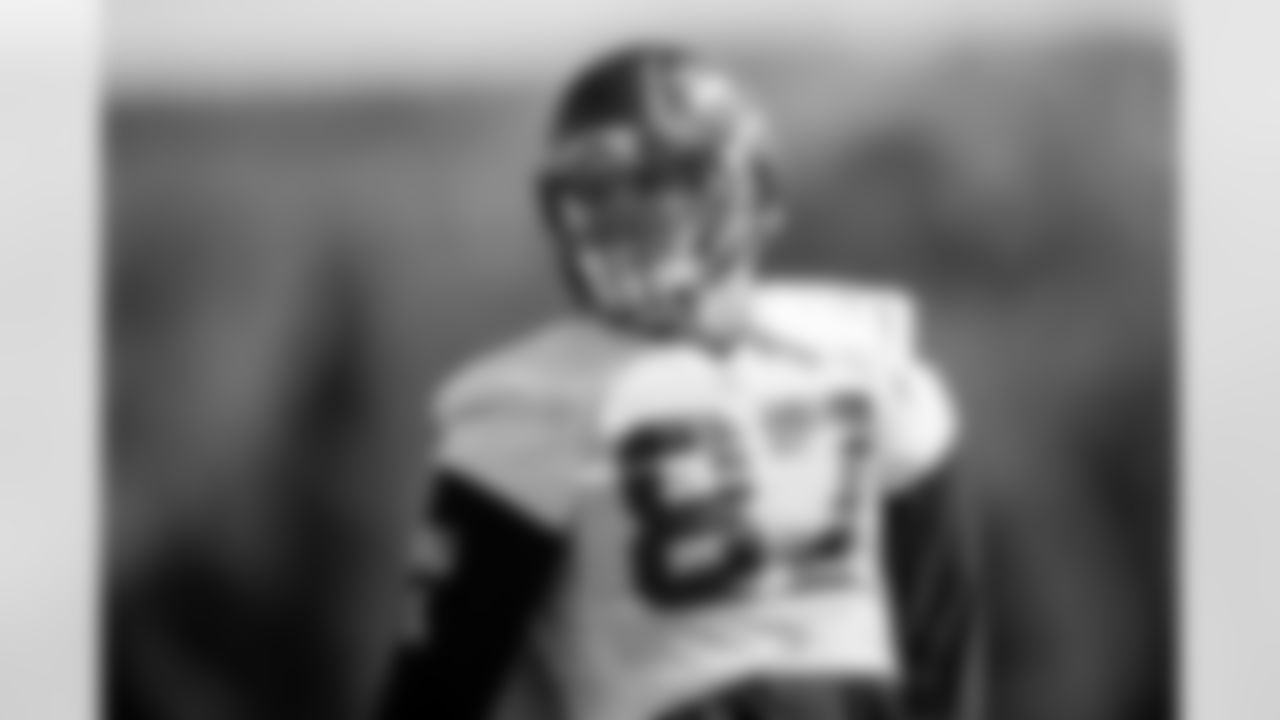Football is the ultimate team sport as quarterback Tom Brady and so many others often remind us. That's true for the team as a whole but it's also true on each respective side of the ball. What one player does up front on the defensive line for instance, has an effect on what guys in the secondary are able to do.
Keeping that in mind, think about the Buccaneer defense's performance this postseason. They've tallied five interceptions and 20 passes defensed in these last three games alone. Those are both the most of any team in the playoffs this year. And while it's true most of those numbers come from players in the secondary and those guys are deserving of praise for their efforts in the back level, Defensive Coordinator Todd Bowles knows that there's more that goes into it than that.
"Just playing hard," Bowles said when asked to what he attributed takeaway success in particular to. "Those guys up front, we have some good players over there and they're clicking at the right time. They're playing very well up front and we've been very opportunistic on the back end. They're coming together and making plays at the right time. They smell blood and they go after it."
That's the second time in as many weeks Bowles has said these guys are after blood and I am here for it.
But what I'm getting at here is that all levels of the defense are working in concert with one another and the success the guys up front are having is directly impacting the overall product, whether that be in the turnover battle or defending the run or of course, the pass rush.
You know their names: the Bucs' pass rushing bookends in Shaq Barrett and Jason Pierre-Paul. They combined for 17.5 sacks in the regular season and five sacks in the NFC Championship game alone against Aaron Rodgers, who was one of the least-sacked quarterbacks this year. But while the stats will only show up for JPP and Shaq, there is much more at play here. Having guys that are able to amass such numbers doesn't happen by accident. JPP isn't being left one-on-one for the heck of it. No, it's out of necessity. Because the guys on the interior of the defensive line are eating up blockers like it's, well, their job. And they're doing a darn good job of it.
"I go back and look at the stats and the two leading quarterback hit guys on our team I would have thought would have been Shaq and JPP, but it was actually [Ndamukong] Suh and Will Gholston," said defensive line coach Kacy Rodgers. "Those guys understand that we have two dynamic pass rushers on the outside and we expect them to win their share of one-on-ones but we have to do a heck of a job winning our one-on-ones inside when it presents itself [while] also pushing the pressure so the quarterback can't step up and get away from those guys. So, it works hand-in-hand."
"I pride myself on making guys around me better and even if you are already elite, making you that much better so definitely excited about that," continued Suh, who has 79 quarterback pressures since the start of 2019, which is the fifth-most in that span among interior defensive linemen. "We really have focused on having the opportunity as our front seven and especially the interior guys like myself and Will, of just working on our craft and being able to say we're just as athletic and we're just as fast. We fight all the time about who's more athletic between me and Will and so we had really a running bet on who could get to the quarterback first, who's going to hit him, who can get their quarterback hits and so being able to be competitive is an aspect of us as a collective group that's just really been infectious and infectious in a positive way. We're excited about that and we want to continue to do that."
Suh and Gholston weren't without their actual sacks either this season, for the record. Suh finished with the most sacks he's had in a season since 2015 with 6.0. The Bucs got 13.0 sacks this year from interior linemen overall.
But one of the ways Suh, and really any of the interior guys can make their mark, is by being effective when the Bucs rush just four. All five of the Bucs' sacks against the Packers came on your standard four-man rush. That means that Tampa Bay was able to disrupt Rodgers while still also accounting for all the weapons he had on the field by having an extra defender on the back end, instead of another guy up front busying himself getting to the quarterback on say a five or six-man blitz. In fact, the Bucs' blitz rate went down as the season went on in general, blitzing on 33% of dropbacks since Week 11, according to NFL Next Gen Stats. That ranks 12th in the league in that span and is down from 42% from Weeks 1-10.
This is where we differentiate blitzing from pressure, though. Not blitzing doesn't matter as long as you're still getting pressure and the Bucs' defense was able to do that with just four guys in Green Bay… and the rest of the postseason for that matter. When bringing just four rushers, quarterbacks under pressure have just a 33.3% completion rate against the Bucs and two of the Bucs' five interceptions in the playoffs have come under such circumstances. That pressure is achieved with just four or fewer guys 27.7% of the time, which is actually more the 25.2% rate when bringing five or less.
That matters.
"It really does in this day and age, no different than what we're going to face on Sunday," said Suh. "When you face a team with dynamic receivers and a dynamic quarterback, you better be able to pressure with sometimes three, sometimes four to get to the quarterback because you're going to need the extra defenders to cover all these different routes and route combinations the guys on the back end are seeing. So, it helps greatly if we can win one on one and get to the quarterback or we cause enough pressure where they're having to chip us or double us, which slows them down in their routes and give our DBs and linebackers a chance to match them up down the field. But with the dynamic speed of the teams and receivers we play week in and week out, the four-man rush definitely helps because when you pressure and blitz them and you have them one on one, one missed tackle, one beat off the ball, you have an explosive play."
That's one thing the Bucs cannot afford against the Chiefs… again. It's what burned them the last time around, by Suh's own admission on Monday. Quarterback Patrick Mahomes defies convention in so many ways but maybe none more impressive than what he can do against the blitz. Mahomes has the second-best completion percentage against the blitz in 2020, including the postseason, at 68.4%. His 9.5 yards per attempt, 15-0 touchdown to interception ratio and 135.3 passer rating against the blitz rank first. Yeah, Mahomes has a 135.3 passer rating when he sees five or more guys in his face.
And the Bucs know that. Even back in Week 12, they only blitzed Mahomes on 17% of his dropbacks, which was the lowest rate in a game under Bowles since he arrived in 2019. But while Mahomes is good against the blitz – he's not as good against pressure. Again, making the distinction between blitzing and pressure. They are not one in the same. Under pressure, Mahomes has a completion percentage of just 48.0%. His passing yards per attempt goes down to 6.3. He's got a 5-1 touchdown to interception rate and his passer rating is down from 116.4 when not facing pressure to 78.7 when he is. Ten of Mahomes' 25 interceptions since 2018 have come against pressure.
So clearly, you need to pressure him. But maybe not blitz him…
Which is again why a four-man rush that can generate pressure will be so crucial against the Chiefs. The good news is that said four-man rush will now also be helped by nose tackle Vita Vea, who returned against the Packers after a 15-week absence due to a broken ankle. He played 46% of the team's defensive snaps in his first game back and had his presence felt, especially against the run, and in a couple of those sacks stolen by JPP and Barrett. The Bucs are simply a better team with Vea on the field and the Next Gen Stats back that up.
Against the run when Vea is on the field the Bucs give up an average of just 2.7 yards per carry. When he isn't, it jumps up to 3.9 yards per carry. Against the pass, the Bucs had a 32.7% quarterback pressure rate and a 10.5% sack rate in 153 dropbacks with Vea on the field. Without Vea, the Bucs have a 26.0% quarterback pressure rate and a 5.9% sack rate. That's a huge difference.
"The thing people really don't know about Vita is that he continued to come to every meeting," said his coach, Kacy Rodgers, talking about the immediate aftermath of Vea's Week Five injury. "Most guys when they go on IR, they come in, get their treatment and they're done but Vita was still out there on his cart watching individual [drills] and came to every meeting so once we got him back, he was on point and hadn't missed anything from the meeting standpoint whatsoever. So, I was just really happy. We knew he had a chance to come back and I knew in practice, he was going to show he was ready to go. It was a big lift seeing the big guy out there."
A big lift, literally.
View some of the top photos from Buccaneers Super Bowl practice at the AdventHealth Training Center.

TAMPA, FL - JANUARY 29, 2021 - Head Coach Bruce Arians of the Tampa Bay Buccaneers during practice at AdventHealth Training Center prior to Super Bowl LV. Photo By Tori Richman/Tampa Bay Buccaneers

TAMPA, FL - JANUARY 29, 2021 - Tackle Tristan Wirfs #78, Guard Aaron Stinnie #64, and Offensive Tackle Donovan Smith #76 of the Tampa Bay Buccaneers during practice at AdventHealth Training Center prior to Super Bowl LV. Photo By Tori Richman/Tampa Bay Buccaneers

TAMPA, FL - JANUARY 29, 2021 - Tackle Tristan Wirfs #78, Guard Aaron Stinnie #64, and Offensive Tackle Donovan Smith #76 of the Tampa Bay Buccaneers during practice at AdventHealth Training Center prior to Super Bowl LV. Photo By Tori Richman/Tampa Bay Buccaneers

TAMPA, FL - JANUARY 29, 2021 - Wide Receiver Scotty Miller #10 of the Tampa Bay Buccaneers during practice at AdventHealth Training Center prior to Super Bowl LV. Photo By Tori Richman/Tampa Bay Buccaneers

TAMPA, FL - JANUARY 29, 2021 - Wide Receiver Scotty Miller #10 of the Tampa Bay Buccaneers during practice at AdventHealth Training Center prior to Super Bowl LV. Photo By Tori Richman/Tampa Bay Buccaneers
![TAMPA, FL - JANUARY 29, 2021 - Wide Receiver Tyler Johnson #18 of the Tampa Bay Buccaneers] during practice at AdventHealth Training Center prior to Super Bowl LV. Photo By Tori Richman/Tampa Bay Buccaneers](https://static.clubs.nfl.com/image/private/t_new_photo_album/t_lazy/f_auto/buccaneers/ou6ib06bdi8boydnaprt.jpg)
TAMPA, FL - JANUARY 29, 2021 - Wide Receiver Tyler Johnson #18 of the Tampa Bay Buccaneers] during practice at AdventHealth Training Center prior to Super Bowl LV. Photo By Tori Richman/Tampa Bay Buccaneers

TAMPA, FL - JANUARY 29, 2021 - Inside Linebacker Kevin Minter #51 of the Tampa Bay Buccaneers during practice at AdventHealth Training Center prior to Super Bowl LV. Photo By Kyle Zedaker/Tampa Bay Buccaneers

TAMPA, FL - JANUARY 29, 2021 - Inside Linebacker Kevin Minter #51 of the Tampa Bay Buccaneers during practice at AdventHealth Training Center prior to Super Bowl LV. Photo By Kyle Zedaker/Tampa Bay Buccaneers

TAMPA, FL - JANUARY 29, 2021 - Wide Receiver Chris Godwin #14 of the Tampa Bay Buccaneers during practice at AdventHealth Training Center prior to Super Bowl LV. Photo By Tori Richman/Tampa Bay Buccaneers

TAMPA, FL - JANUARY 29, 2021 - Guard John Molchon #75 of the Tampa Bay Buccaneers during practice at AdventHealth Training Center prior to Super Bowl LV. Photo By Kyle Zedaker/Tampa Bay Buccaneers

TAMPA, FL - JANUARY 29, 2021 - Quarterback Tom Brady #12 of the Tampa Bay Buccaneers during practice at AdventHealth Training Center prior to Super Bowl LV. Photo By Tori Richman/Tampa Bay Buccaneers

TAMPA, FL - JANUARY 29, 2021 - Running Back Ke'Shawn Vaughn #30 of the Tampa Bay Buccaneers during practice at AdventHealth Training Center prior to Super Bowl LV. Photo By Tori Richman/Tampa Bay Buccaneers

TAMPA, FL - JANUARY 29, 2021 - Outside Linebacker Cam Gill #49 of the Tampa Bay Buccaneers during practice at AdventHealth Training Center prior to Super Bowl LV. Photo By Kyle Zedaker/Tampa Bay Buccaneers

TAMPA, FL - JANUARY 29, 2021 - Outside Linebacker Quinton Bell #57 of the Tampa Bay Buccaneers during practice at AdventHealth Training Center prior to Super Bowl LV. Photo By Kyle Zedaker/Tampa Bay Buccaneers

TAMPA, FL - JANUARY 29, 2021 - Tackle Tristan Wirfs #78 of the Tampa Bay Buccaneers during practice at AdventHealth Training Center prior to Super Bowl LV. Photo By Tori Richman/Tampa Bay Buccaneers

TAMPA, FL - JANUARY 29, 2021 - Running Back LeSean McCoy #25 of the Tampa Bay Buccaneers during practice at AdventHealth Training Center prior to Super Bowl LV. Photo By Tori Richman/Tampa Bay Buccaneers

TAMPA, FL - JANUARY 29, 2021 - Outside Linebacker Cam Gill #49 of the Tampa Bay Buccaneers during practice at AdventHealth Training Center prior to Super Bowl LV. Photo By Kyle Zedaker/Tampa Bay Buccaneers

TAMPA, FL - JANUARY 29, 2021 - Wide Receiver Jaydon Mickens #85 of the Tampa Bay Buccaneers during practice at AdventHealth Training Center prior to Super Bowl LV. Photo By Tori Richman/Tampa Bay Buccaneers

TAMPA, FL - JANUARY 29, 2021 - Outside Linebacker Quinton Bell #57 of the Tampa Bay Buccaneers during practice at AdventHealth Training Center prior to Super Bowl LV. Photo By Kyle Zedaker/Tampa Bay Buccaneers

TAMPA, FL - JANUARY 29, 2021 - Wide Receiver Mike Evans #13 of the Tampa Bay Buccaneers during practice at AdventHealth Training Center prior to Super Bowl LV. Photo By Tori Richman/Tampa Bay Buccaneers

TAMPA, FL - JANUARY 29, 2021 - Outside Linebacker Cam Gill #49 of the Tampa Bay Buccaneers during practice at AdventHealth Training Center prior to Super Bowl LV. Photo By Kyle Zedaker/Tampa Bay Buccaneers

TAMPA, FL - JANUARY 29, 2021 - Outside Linebacker Shaquil Barrett #58 of the Tampa Bay Buccaneers during practice at AdventHealth Training Center prior to Super Bowl LV. Photo By Kyle Zedaker/Tampa Bay Buccaneers

TAMPA, FL - JANUARY 29, 2021 - Guard Ted Larsen #62 of the Tampa Bay Buccaneers during practice at AdventHealth Training Center prior to Super Bowl LV. Photo By Tori Richman/Tampa Bay Buccaneers

TAMPA, FL - JANUARY 29, 2021 - Football during practice at AdventHealth Training Center prior to Super Bowl LV. Photo By Kyle Zedaker/Tampa Bay Buccaneers

TAMPA, FL - JANUARY 29, 2021 - Tight End Antony Auclair #82 of the Tampa Bay Buccaneers during practice at AdventHealth Training Center prior to Super Bowl LV. Photo By Tori Richman/Tampa Bay Buccaneers

TAMPA, FL - JANUARY 29, 2021 - Guard Ali Marpet #74 of the Tampa Bay Buccaneers during practice at AdventHealth Training Center prior to Super Bowl LV. Photo By Tori Richman/Tampa Bay Buccaneers

TAMPA, FL - JANUARY 29, 2021 - Defensive Lineman Jeremiah Ledbetter #95 and Guard John Molchon #75 of the Tampa Bay Buccaneers during practice at AdventHealth Training Center prior to Super Bowl LV. Photo By Kyle Zedaker/Tampa Bay Buccaneers

TAMPA, FL - JANUARY 29, 2021 - Guard Ali Marpet #74 of the Tampa Bay Buccaneers during practice at AdventHealth Training Center prior to Super Bowl LV. Photo By Tori Richman/Tampa Bay Buccaneers

TAMPA, FL - JANUARY 29, 2021 - Guard Earl Watford #70 of the Tampa Bay Buccaneers during practice at AdventHealth Training Center prior to Super Bowl LV. Photo By Kyle Zedaker/Tampa Bay Buccaneers

TAMPA, FL - JANUARY 29, 2021 - Quarterback Tom Brady #12 of the Tampa Bay Buccaneers during practice at AdventHealth Training Center prior to Super Bowl LV. Photo By Tori Richman/Tampa Bay Buccaneers

TAMPA, FL - JANUARY 29, 2021 - Wide Receiver Travis Jonsen #16 of the Tampa Bay Buccaneers during practice at AdventHealth Training Center prior to Super Bowl LV. Photo By Tori Richman/Tampa Bay Buccaneers

TAMPA, FL - JANUARY 29, 2021 - Wide Receiver Chris Godwin #14 of the Tampa Bay Buccaneers during practice at AdventHealth Training Center prior to Super Bowl LV. Photo By Tori Richman/Tampa Bay Buccaneers

TAMPA, FL - JANUARY 29, 2021 - Defensive Lineman Jeremiah Ledbetter #95, Defensive Tackle Vita Vea #50, and Defensive Lineman Patrick O'Connor #79 of the Tampa Bay Buccaneers during practice at AdventHealth Training Center prior to Super Bowl LV. Photo By Kyle Zedaker/Tampa Bay Buccaneers

TAMPA, FL - JANUARY 29, 2021 - Quarterback Tom Brady #12 of the Tampa Bay Buccaneers during practice at AdventHealth Training Center prior to Super Bowl LV. Photo By Tori Richman/Tampa Bay Buccaneers

TAMPA, FL - JANUARY 29, 2021 - Wide Receiver Tyler Johnson #18 of the Tampa Bay Buccaneers during practice at AdventHealth Training Center prior to Super Bowl LV. Photo By Tori Richman/Tampa Bay Buccaneers

TAMPA, FL - JANUARY 29, 2021 - Defensive Tackle Vita Vea #50 of the Tampa Bay Buccaneers during practice at AdventHealth Training Center prior to Super Bowl LV. Photo By Kyle Zedaker/Tampa Bay Buccaneers

TAMPA, FL - JANUARY 29, 2021 - Cornerback Sean Murphy-Bunting #23, Cornerback Ross Cockrell #43, and Cornerback Herb Miller #36 of the Tampa Bay Buccaneers during practice at AdventHealth Training Center prior to Super Bowl LV. Photo By Kyle Zedaker/Tampa Bay Buccaneers

TAMPA, FL - JANUARY 29, 2021 - Cornerback Carlton Davis #24 of the Tampa Bay Buccaneers during practice at AdventHealth Training Center prior to Super Bowl LV. Photo By Kyle Zedaker/Tampa Bay Buccaneers

TAMPA, FL - JANUARY 29, 2021 - Cornerback Ryan Smith #29 of the Tampa Bay Buccaneers during practice at AdventHealth Training Center prior to Super Bowl LV. Photo By Kyle Zedaker/Tampa Bay Buccaneers

TAMPA, FL - JANUARY 29, 2021 - Cornerback Carlton Davis #24 of the Tampa Bay Buccaneers during practice at AdventHealth Training Center prior to Super Bowl LV. Photo By Kyle Zedaker/Tampa Bay Buccaneers

TAMPA, FL - JANUARY 29, 2021 - Inside Linebacker Devin White #45 of the Tampa Bay Buccaneers during practice at AdventHealth Training Center prior to Super Bowl LV. Photo By Tori Richman/Tampa Bay Buccaneers

TAMPA, FL - JANUARY 29, 2021 - Linebacker/Safety Deone Bucannon #41 of the Tampa Bay Buccaneers during practice at AdventHealth Training Center prior to Super Bowl LV. Photo By Kyle Zedaker/Tampa Bay Buccaneers

TAMPA, FL - JANUARY 29, 2021 - Defensive Tackle Rakeem Nunez-Roches #56 of the Tampa Bay Buccaneers during practice at AdventHealth Training Center prior to Super Bowl LV. Photo By Kyle Zedaker/Tampa Bay Buccaneers

TAMPA, FL - JANUARY 29, 2021 - Defensive Tackle Ndamukong Suh #93 of the Tampa Bay Buccaneers during practice at AdventHealth Training Center prior to Super Bowl LV. Photo By Kyle Zedaker/Tampa Bay Buccaneers

TAMPA, FL - JANUARY 29, 2021 - Defensive Lineman Patrick O'Connor #79 and Tackle Joe Haeg #73 of the Tampa Bay Buccaneers during practice at AdventHealth Training Center prior to Super Bowl LV. Photo By Tori Richman/Tampa Bay Buccaneers

TAMPA, FL - JANUARY 29, 2021 - Defensive Tackle Ndamukong Suh #93 of the Tampa Bay Buccaneers during practice at AdventHealth Training Center prior to Super Bowl LV. Photo By Kyle Zedaker/Tampa Bay Buccaneers

TAMPA, FL - JANUARY 29, 2021 - Defensive Tackle Vita Vea #50 of the Tampa Bay Buccaneers during practice at AdventHealth Training Center prior to Super Bowl LV. Photo By Tori Richman/Tampa Bay Buccaneers

TAMPA, FL - JANUARY 29, 2021 - Inside Linebacker Devin White #45 of the Tampa Bay Buccaneers during practice at AdventHealth Training Center prior to Super Bowl LV. Photo By Kyle Zedaker/Tampa Bay Buccaneers

TAMPA, FL - JANUARY 29, 2021 - Defensive Tackle Vita Vea #50 of the Tampa Bay Buccaneers during practice at AdventHealth Training Center prior to Super Bowl LV. Photo By Kyle Zedaker/Tampa Bay Buccaneers

TAMPA, FL - JANUARY 29, 2021 - Outside Linebacker Anthony Nelson #98 of the Tampa Bay Buccaneers during practice at AdventHealth Training Center prior to Super Bowl LV. Photo By Kyle Zedaker/Tampa Bay Buccaneers

TAMPA, FL - JANUARY 29, 2021 - Inside Linebacker Devin White #45 of the Tampa Bay Buccaneers during practice at AdventHealth Training Center prior to Super Bowl LV. Photo By Kyle Zedaker/Tampa Bay Buccaneers

TAMPA, FL - JANUARY 29, 2021 - Inside Linebacker Kevin Minter #51 of the Tampa Bay Buccaneers during practice at AdventHealth Training Center prior to Super Bowl LV. Photo By Tori Richman/Tampa Bay Buccaneers

TAMPA, FL - JANUARY 29, 2021 - Head Coach Bruce Arians of the Tampa Bay Buccaneers during practice at AdventHealth Training Center prior to Super Bowl LV. Photo By Tori Richman/Tampa Bay Buccaneers

TAMPA, FL - JANUARY 29, 2021 - Wide Receiver Mike Evans #13 of the Tampa Bay Buccaneers during practice at AdventHealth Training Center prior to Super Bowl LV. Photo By Tori Richman/Tampa Bay Buccaneers

TAMPA, FL - JANUARY 29, 2021 - Defensive Lineman William Gholston #92 of the Tampa Bay Buccaneers during practice at AdventHealth Training Center prior to Super Bowl LV. Photo By Kyle Zedaker/Tampa Bay Buccaneers

TAMPA, FL - JANUARY 29, 2021 - Running Back Ronald Jones II #27 of the Tampa Bay Buccaneers during practice at AdventHealth Training Center prior to Super Bowl LV. Photo By Tori Richman/Tampa Bay Buccaneers

TAMPA, FL - JANUARY 29, 2021 - Inside Linebacker Devin White #45 of the Tampa Bay Buccaneers during practice at AdventHealth Training Center prior to Super Bowl LV. Photo By Kyle Zedaker/Tampa Bay Buccaneers

TAMPA, FL - JANUARY 29, 2021 - Quarterback Tom Brady #12 of the Tampa Bay Buccaneers during practice at AdventHealth Training Center prior to Super Bowl LV. Photo By Tori Richman/Tampa Bay Buccaneers

TAMPA, FL - JANUARY 29, 2021 - Quarterback Tom Brady #12 of the Tampa Bay Buccaneers during practice at AdventHealth Training Center prior to Super Bowl LV. Photo By Tori Richman/Tampa Bay Buccaneers

TAMPA, FL - JANUARY 29, 2021 - Running Back LeSean McCoy #25 of the Tampa Bay Buccaneers during practice at AdventHealth Training Center prior to Super Bowl LV. Photo By Kyle Zedaker/Tampa Bay Buccaneers

TAMPA, FL - JANUARY 29, 2021 - Running Back LeSean McCoy #25 of the Tampa Bay Buccaneers during practice at AdventHealth Training Center prior to Super Bowl LV. Photo By Kyle Zedaker/Tampa Bay Buccaneers

TAMPA, FL - JANUARY 29, 2021 - Center Ryan Jensen #66 of the Tampa Bay Buccaneers during practice at AdventHealth Training Center prior to Super Bowl LV. Photo By Tori Richman/Tampa Bay Buccaneers

TAMPA, FL - JANUARY 29, 2021 - Defensive Lineman Benning Potoa'e #91 of the Tampa Bay Buccaneers during practice at AdventHealth Training Center prior to Super Bowl LV. Photo By Kyle Zedaker/Tampa Bay Buccaneers

TAMPA, FL - JANUARY 29, 2021 - Inside Linebacker Kevin Minter #51 of the Tampa Bay Buccaneers during practice at AdventHealth Training Center prior to Super Bowl LV. Photo By Tori Richman/Tampa Bay Buccaneers

TAMPA, FL - JANUARY 29, 2021 - Outside Linebacker Shaquil Barrett #58 of the Tampa Bay Buccaneers during practice at AdventHealth Training Center prior to Super Bowl LV. Photo By Tori Richman/Tampa Bay Buccaneers

TAMPA, FL - JANUARY 29, 2021 - Safety Mike Edwards #32 of the Tampa Bay Buccaneers during practice at AdventHealth Training Center prior to Super Bowl LV. Photo By Kyle Zedaker/Tampa Bay Buccaneers

TAMPA, FL - JANUARY 29, 2021 - Cornerback Carlton Davis #24 of the Tampa Bay Buccaneers during practice at AdventHealth Training Center prior to Super Bowl LV. Photo By Kyle Zedaker/Tampa Bay Buccaneers

TAMPA, FL - JANUARY 29, 2021 - Cornerback Carlton Davis #24 of the Tampa Bay Buccaneers during practice at AdventHealth Training Center prior to Super Bowl LV. Photo By Kyle Zedaker/Tampa Bay Buccaneers

TAMPA, FL - JANUARY 29, 2021 - Linebacker/Safety Deone Bucannon #41 of the Tampa Bay Buccaneers during practice at AdventHealth Training Center prior to Super Bowl LV. Photo By Kyle Zedaker/Tampa Bay Buccaneers

TAMPA, FL - JANUARY 29, 2021 - Inside Linebacker Devin White #45 of the Tampa Bay Buccaneers during practice at AdventHealth Training Center prior to Super Bowl LV. Photo By Kyle Zedaker/Tampa Bay Buccaneers

TAMPA, FL - JANUARY 29, 2021 - Inside Linebacker Devin White #45 of the Tampa Bay Buccaneers during practice at AdventHealth Training Center prior to Super Bowl LV. Photo By Kyle Zedaker/Tampa Bay Buccaneers

TAMPA, FL - JANUARY 29, 2021 - Outside Linebackers Coach Larry Foote, Outside Linebacker Shaquil Barrett #58, Wide Receiver Mike Evans #13, and Wide Receiver Chris Godwin #14 of the Tampa Bay Buccaneers during practice at AdventHealth Training Center prior to Super Bowl LV. Photo By Kyle Zedaker/Tampa Bay Buccaneers

TAMPA, FL - JANUARY 29, 2021 - Wide Receiver Chris Godwin #14 of the Tampa Bay Buccaneers during practice at AdventHealth Training Center prior to Super Bowl LV. Photo By Kyle Zedaker/Tampa Bay Buccaneers

TAMPA, FL - JANUARY 29, 2021 - Defensive Lineman William Gholston #92 and Defensive Lineman Patrick O'Connor #79 of the Tampa Bay Buccaneers during practice at AdventHealth Training Center prior to Super Bowl LV. Photo By Kyle Zedaker/Tampa Bay Buccaneers

TAMPA, FL - JANUARY 29, 2021 - Quarterback Tom Brady #12 of the Tampa Bay Buccaneers during practice at AdventHealth Training Center prior to Super Bowl LV. Photo By Tori Richman/Tampa Bay Buccaneers

TAMPA, FL - JANUARY 29, 2021 - Offensive Tackle Donovan Smith #76 of the Tampa Bay Buccaneers during practice at AdventHealth Training Center prior to Super Bowl LV. Photo By Tori Richman/Tampa Bay Buccaneers

TAMPA, FL - JANUARY 29, 2021 - Wide Receiver Tyler Johnson #18 of the Tampa Bay Buccaneers during practice at AdventHealth Training Center prior to Super Bowl LV. Photo By Tori Richman/Tampa Bay Buccaneers


TAMPA, FL - JANUARY 29, 2021 - Tackle Joe Haeg #73 of the Tampa Bay Buccaneers during practice at AdventHealth Training Center prior to Super Bowl LV. Photo By Tori Richman/Tampa Bay Buccaneers

TAMPA, FL - JANUARY 29, 2021 - Cornerback Sean Murphy-Bunting #23 of the Tampa Bay Buccaneers during practice at AdventHealth Training Center prior to Super Bowl LV. Photo By Kyle Zedaker/Tampa Bay Buccaneers

TAMPA, FL - JANUARY 29, 2021 - Guard Earl Watford #70 of the Tampa Bay Buccaneers during practice at AdventHealth Training Center prior to Super Bowl LV. Photo By Kyle Zedaker/Tampa Bay Buccaneers

TAMPA, FL - JANUARY 29, 2021 - Quarterback Blaine Gabbert #11 of the Tampa Bay Buccaneers during practice at AdventHealth Training Center prior to Super Bowl LV. Photo By Kyle Zedaker/Tampa Bay Buccaneers

TAMPA, FL - JANUARY 29, 2021 - Wide Receiver Tyler Johnson #18 of the Tampa Bay Buccaneers during practice at AdventHealth Training Center prior to Super Bowl LV. Photo By Tori Richman/Tampa Bay Buccaneers

TAMPA, FL - JANUARY 29, 2021 - Wide Receiver Jaydon Mickens #85 of the Tampa Bay Buccaneers during practice at AdventHealth Training Center prior to Super Bowl LV. Photo By Tori Richman/Tampa Bay Buccaneers

TAMPA, FL - JANUARY 29, 2021 - Cornerback Herb Miller #36 and Wide Receiver Tyler Johnson #18 of the Tampa Bay Buccaneers during practice at AdventHealth Training Center prior to Super Bowl LV. Photo By Tori Richman/Tampa Bay Buccaneers
He and guys like Suh and Gholston will be paramount to maintaining the integrity of the interior and helping the Bucs win up front. That will help pretty much every facet of the game as they take on a very versatile Chiefs offense on Sunday for Super Bowl LV.
"They've only given up 29.0 sacks on the year I believe, with as many times as they throw the ball," said Rodgers. "They're averaging 4.5 yards per rush. You say they're a passing team but when they run the ball, they're highly, highly efficient so with them having their injuries on the offensive line and moving people around, we anticipate those guys will perform well and at a high level because they've done it all year long."


































